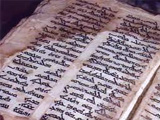|
|
TODAY.AZ / Weird / Interesting
Symbol in Syriac may be world's first question mark
24 July 2011 [12:24] - TODAY.AZ
 What could be the world's earliest example of a question mark has been identified in Classical Syriac manuscripts dating from the 5th Century.
What could be the world's earliest example of a question mark has been identified in Classical Syriac manuscripts dating from the 5th Century.The symbol, a double dot resembling the modern colon, is known as the "zagwa elaya," or "upper pair." Its function as a question mark was pinned down by Chip Coakley, a manuscript specialist at Cambridge University.
By studying the biblical manuscripts at the British Museum in London, Coakley was able to solve the mystery of the two dots, which has puzzled grammarians for decades, and described his finding as a "significant footnote in the history of writing."
"When you are sitting round a table reading a Syriac text with students, they ask all kinds of questions -- like what the heck does this or that dot mean -- and you want to be able to answer them," said Coakley.
"It's satisfying to have made sense of some of those weird dots."
Although the zagwa elaya is discussed in later grammatical tracts, it was not identified correctly, Coakley told Reuters.
"Later grammarians did talk about it but did not really know how it was used. They thought it indicated sarcasm or reproof, which turns out to only be partly true.
"I went back to the earliest manuscripts in the British Library to see how the zagwa elaya was used there. These were manuscripts later grammarians did not have access to."
Coakley's discovery that the zagwa elaya may in fact be a question mark identifies Syriac as the first language to use punctuation as a grammatical indicator of a question.
"Other languages, such as Hebrew, use particles to mark questions but in Classical Syriac we see the sagwa elaya as a grammatical marker," Coakley said.
The zagwa elaya is written at the start of declarative sentences to indicate their function as questions, something which would otherwise be ambiguous.
It is not used in questions with interrogative words, the equivalents of "wh-words" in English.
This is significant for theories of how the ancient language might have sounded, said the researcher.
"Reading aloud, the same function is served by a rising tone of voice -- or at least it is in English -- and it is interesting to ponder whether zawga elaya really marks the grammar of the question, or whether it is a direction to someone reading the Bible aloud to modulate their voice," Coakley said.
Syriac is thought to have appeared in the Middle East from the 1st Century and boasts a large Christian literature. It declined as a spoken language with the arrival of Islam and Arabic and today is only used in churches.
/Yahoo News/
URL: http://www.today.az/news/interesting/91207.html
 Print version
Print version
Views: 2199
Connect with us. Get latest news and updates.
See Also
- 19 February 2025 [22:20]
Visa and Mastercard can return to Russia, but with restrictions - 05 February 2025 [19:41]
Japan plans to negotiate with Trump to increase LNG imports from United States - 23 January 2025 [23:20]
Dubai once again named cleanest city in the world - 06 December 2024 [22:20]
Are scented candles harmful to health? - 23 November 2024 [14:11]
Magnitude 4.5 earthquake hits Azerbaijan's Lachin - 20 November 2024 [23:30]
Launch vehicle with prototype of Starship made its sixth test flight - 27 October 2024 [09:00]
Fuel prices expected to rise in Sweden - 24 October 2024 [19:14]
Turkiye strikes terror targets in Iraq and Syria - 23 October 2024 [23:46]
Kazakhstan supplied almost entire volume of oil planned for 2024 to Germany in 9 months - 23 October 2024 [22:17]
Taiwan reported passage of Chinese Navy aircraft carrier near island
Most Popular
 What von der Leyen doesn't know about. Or doesn't want to know
What von der Leyen doesn't know about. Or doesn't want to know
 Turkish auto sector shifts gears for green transformation
Turkish auto sector shifts gears for green transformation
 Bayramov: Direct talks yield better results than mediated dialogue
Bayramov: Direct talks yield better results than mediated dialogue
 Japan grants $3 billion loan to Ukraine using profits from frozen Russian assets
Japan grants $3 billion loan to Ukraine using profits from frozen Russian assets
 Baku spends over 1 billion manats on education in Q1
Baku spends over 1 billion manats on education in Q1
 America’s tariff strategy risks fragmenting global economy
America’s tariff strategy risks fragmenting global economy
 At least 148 dead after boat accident on DR Congo river
At least 148 dead after boat accident on DR Congo river
